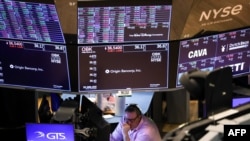ດັດຊະນີຕະຫຼາດຮຸ້ນທັງສາມຂອງ ສະຫະລັດ ໄດ້ຕົກລົງຢ່າງວ່ອງໄວໃນການຊື້ຂາຍຂອງວັນຈັນວານນີ້ ເນື່ອງຈາກນັກລົງທຶນມີຄວາມເປັນຫ່ວງ ກ່ຽວກັບ ຄວາມບໍ່ແນ່ນອນຂອງພາສີທີ່ປະທານາທິບໍດີ ດໍໂນລ ທຣຳ ກຳນົດກັບຄູ່ຮ່ວມມືທາງການຄ້າຫຼັກ ແລະ ຄວາມບໍ່ເຕັມໃຈທີ່ຈະຕັດຄວາມເປັນໄປໄດ້ຂອງພາວະເສດຖະກິດຖົດຖອຍຂອງ ສະຫະລັດ ໃນອີກບໍ່ເທົ່າໃດເດືອນຂ້າງໜ້າ.
ດັດຊະນີ Dow Jones ຊຶ່ງປະກອບດ້ວຍຮຸ້ນບລູຊິບ 30 ຮຸ້ນໄດ້ຫຼຸດລົງ 2.1 ເມື່ອສິ້ນສຸດການຊື້ຂາຍຂອງວັນຈັນ ໂດຍດັດຊະນີ S&P 500 ຫຼຸດລົງ 2.7 ແລະ ດັດຊະນີ Nasdaq ຊຶ່ງເນັ້ນຮຸ້ນເທັກໂນໂລຈີ ຫຼຸດລົງ 4 ເປີເຊັນ.
ດັດຊະນີ S&P 500 ໄດ້ຕົກລົງຫຼາຍທີ່ສຸດໃຍຮອບວັນນັບຕັ້ງແຕ່ວັນທີ 18 ທັນວາ ແລະ ຕົກລົງ 8.6 ເປີເຊັນຈາກຈຸດສູງສຸດຕະຫຼອດການທີ່ເຮັດໄວ້ເມື່ອບໍ່ເຖິງນຶ່ງເດືອນທີ່ຜ່ານມາເມື່ອວັນທີ 19 ກຸມພາ. ດັດຊະນີ Nasdaq ໄດ້ຕົກລົງຫຼາຍທີ່ສຸດໃນຮອບວັນນັບຕັ້ງແຕ່ເດືອນກັນຍາ 2022.
ເມື່ອອາທິດທີ່ຜ່ານມາທ່ານ ທຣຳ ໄດ້ກຳນົດພາສີນຳເຂົ້າສິນຄ້າຈາກ ເມັກຊິໂກ ແລະ ການາດາ ມາຍັງ ສະຫະລັດ ໃນອັດຕາ 25 ເປີເຊັນ ແລະ ລັງຈາກນັ້ນບໍ່ເທົ່າໃດວັນ ທ່ານ ທຣຳ ກໍໄດ້ລະງັບການຮຽກເກັບພາສີດັ່ງກ່າວຈົນເຖິງວັນທີ 2 ເມສາ ສົງຜົນໃຫ້ບັນດານັກລົງທຶນຍັງຄົງບໍ່ໝັ້ນໃຈ.
ເມື່ອທ້າຍອາທິດທີ່ຜ່ານມາ ທ່ານ ຮາວເຫວີດ ລັດນິກ ລັດຖະມົນຕີວ່າການກະຊວງການຄ້າກ່າວກັບໂທລະພາບ NBC ວ່າ “ຈະບໍ່ມີພາວະເສດຖະກິດຖົດຖອຍໃນ ອາເມຣິກາ” ແຕ່ທ່ານ ທຣຳ ຊ້ຳພັດຫຼີກລ່ຽງທີ່ຈະເວົ້າເຖິງເລື່ອງນີ້.
ຜູ້ນຳ ສະຫະລັດ ກ່າວກັບໂທລະພາບ Fox News ວ່າ “ຂ້າພະເຈົ້າບໍ່ຢາກຄາດເດົາວ່າແມ່ນຫຍັງຈະເກີດຂຶ້ນແບບນັ້ນ. ມັນມີຊ່ວງເວລາປ່ຽນຜ່ານ ເພາະສິ່ງທີ່ເຮົາກຳລັງເຮັດຢູ່ນັ້ນຍິ່ງໃຫຍ່ຫຼາຍ ເຮົາກຳລັງນຳຄວາມໝັ້ນຄົງກັບຄືນມາສູ່ ສະຫະລັດ ອາເມຣິກາ ນັ້ນເປັນເລື່ອງໃຫຍ່.”
ທ່ານກ່າວເສີມວ່າ “ຕ້ອງໃຊ້ເວລາອີກແດ່.”
ການດຳເນີນການຂຶ້ນພາສີທີ່ເກີດຂຶ້ນແລະບໍ່ເກີດຂຶ້ນຂອງທ່ານ ທຣຳ ໄດ້ເຮັດໃຫ້ດັດຊະນີ S&P 500 ຂຶ້ນຫຼືລົງຫຼາຍກວ່າ 1 ເປີເຊັນເຖິງ 7 ຄັ້ງໃນ 8 ວັນ.
ຄາດວ່າການຂຶ້ນພາສີຮອບຕໍ່ໄປຈະເກີດຂຶ້ນໃນວັນພຸດ ໂດຍຈະເລີ່ມເກັບພາສີເຫຼັກ ແລະ ອາລູມີນຽມ 25 ເປີເຊັນ.
ອ່ານຂ່າວນີ້ເປັນພາສາອັງກິດ
All three major U.S. stock indexes dropped sharply in Monday's trading, with investors worried about the uncertainty of tariffs President Donald Trump imposed on key trading partners and his reluctance to rule out the possibility of a U.S. recession in the coming months.
The key Dow Jones average of 30 blue chip stocks dropped 2.1% by the end of trading Monday, with the broader S&P 500 index falling 2.7% and the tech-heavy Nasdaq barometer off 4%.
The S&P 500 had its biggest one-day drop since December 18 and is down 8.6% from its all-time high set less than one month ago, on February 19. The Nasdaq had its largest single-day percentage drop since September 2022.
Trump imposed new 25% tariffs on Mexican and Canadian exports to the U.S. last week and then days later paused the duties until April 2, leaving investors in a state of uncertainty.
"There's going to be no recession in America," Commerce Secretary Howard Lutnick told NBC News over the weekend, but Trump hedged on the issue.
"I hate to predict things like that," the U.S. leader told Fox News. "There is a period of transition because what we're doing is very big. We're bringing wealth back to America. That's a big thing."
"It takes a little time," he added.
Trump's on-again, off-again tariff actions have led the S&P 500 to swing more than 1%, up or down, seven times in eight days.
The next round of tariffs is expected to take place Wednesday, when levies of 25% on steel and aluminum are due to go into effect.






ຟໍຣັມສະແດງຄວາມຄິດເຫັນ